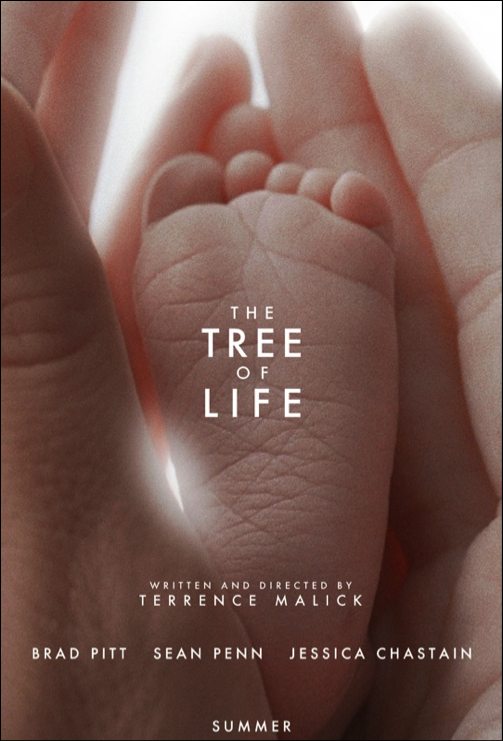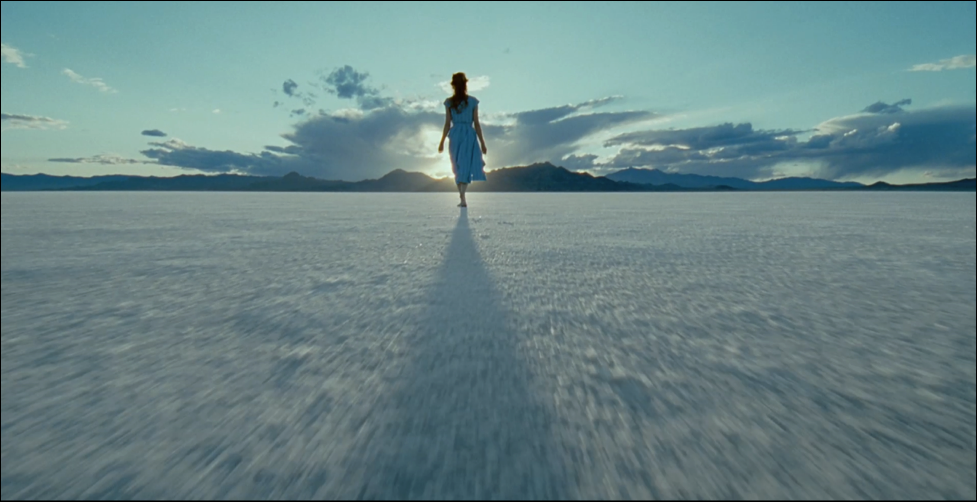 As I exited the Art Theater and walked down Church Street Monday evening all I could ponder was “How on earth am I supposed to write about that?” Critiquing a movie for the most part is rather simple and straight-forward, especially for an opinionated fellow like myself. But what I witnessed Monday was anything but just a movie. Upon arriving home later that evening I was asked what I saw by a friend:
As I exited the Art Theater and walked down Church Street Monday evening all I could ponder was “How on earth am I supposed to write about that?” Critiquing a movie for the most part is rather simple and straight-forward, especially for an opinionated fellow like myself. But what I witnessed Monday was anything but just a movie. Upon arriving home later that evening I was asked what I saw by a friend:
“The Tree of Life” I answered.
“Haven’t heard of it. Who’s in it?”
“Brad Pitt and an actress named Jessica Chastain are the main characters. Sean Penn is also in it”
“Wow Brad Pitt and Sean Penn?” they asked. I can immediately hear their interest peaking “It must be really good!”
I clenched my teeth, dreading the inevitable question to follow.
“So… did you like it?”
Well, crap.
This is what my friends do. They often ask my opinion of the films I see, so this shouldn’t be anything to be afraid of. But this was such a different experience, one that I was already agonizing over how to describe to even myself, let alone others. It would have been so much easier if they asked about Source Code or Midnight in Paris. But ultimately how does anybody sum up The Tree of Life? I mean, how do you actually grade poetry or a piece of art?
And let me backtrack here first; I know what you’re thinking: Here is yet another self righteous, film snob preaching about the “art form” and its subtleties in some elitist, pretentious way only a film critic could. And I think with most movies out there that is actually a fair criticism. It is common for many of us with a passion for cinema to sensationalize what is for the most part a straight forward medium. We search for answers where the questions aren’t even there and in turn try to create deeper substance than that is necessary out of the celluloid. But again, my assertion here is that what I saw Monday night is most definitely not just a movie. This truly was a poem and an artistic interpretation of creation, life and everything in between. And to describe THAT is a difficult enough of a task all while still coming to grips with my own contradicting feelings for what I just witnessed.
At its simplest, The Tree of Life is a reflective journey of a 1950s family, with a stern father, angelic mother and a trio of boys, the eldest bridling at dad’s discipline. But as I’ve attempted to navigate here already, there is nothing simple about Terrence Malick’s film.
This reclusive auteur instead has crafted a highly visual picture that encompasses the entirety of life, dinosaurs included. Dialogue is quite sparse but at a premium when present, whispering through scenes gently hinting at the interpretive depth that lies below. It’s safe to say that Malick doesn’t tell this story in any conventional fashion here and if you are a follower of his work this really shouldn’t be that shocking. Film goers and critics alike are still wrestling with Malick’s earlier pieces, struggling for apt ways to describe their experiences. Badlands, Days of Heaven, The Thin Red Line, The New World– none of these are your typical Hollywood yarn. Those who require conventional narrative are often bored, but others inclined toward poetry and the arts often describe overwhelming emotional experiences that “You just have to feel” they say.
It’s true that our emotional responses are an important, and often undervalued, part of the artistic experience. But these emotions are untrustworthy and generally fleeting. There’s more to a feast than the feeling it gives us. Many avid film-goers, myself included, consider post-viewing discussions as a method to increase the joys and rewards of moviegoing beyond the cinematic adventure itself. The dessert if you will. This allows for criticism and discernment; reflection on the medium to help better understand and dissect the layers before us. For Tree of Life I would argue that this is a necessary part of the experience. But it was within these points though where my own feelings for the picture finally started to manifest.

Now, I’m reluctant to describe all my frustrations here though as I don’t want to discourage anyone from seeing what is surely to be one of the more ambitious and important films of 2011. But some of the euphoric praise I’ve read feels a bit hysterical to me. There is no doubt your experience will be a different one but as a movie-goer the decision to make or not make here is if that is even an adventure to partake in. Do you want an adventurous escape in between handfuls of popcorn or do you want an experimental piece of artwork that is to be admired for 2+ hours? But again here, that is where the conflict for me begins to reside because, and I want to be clear on this point: It wasn’t that I didn’t enjoy myself, I truly did. The cinematography is sure to be garnered with numerous awards this winter and is worth the price of admission alone. The cinematic scope and photography here is just, truly, breathtaking. If a picture is worth a thousand words, I could pen a novel on the flowing river of vivid images that sweep through the screen. These talk to one another. They raise questions about each other as they open up, reflect, and contradict. They pace the film seamlessly, albeit in an unorthodox fashion. Malick began his career decades ago as a storyteller with a flair for the poetic; now he’s evolved into a seasoned artist guiding us through a beautiful exhibition that was painted in a heightened time of inspiration, and the paint on his canvases is still wet. It was a surreal experience on a unique level and one of those film-going ventures that I won’t soon forget.
So that brings me back to the original question: “So… Did you like it?”
And here is where the rubber meets the road. Even days later I still don’t know if I have had enough time to truly answer that question. Great art films challenge each moviegoer to interpret what they’re seeing. What I am learning later in life is that those interpretations often tell us more about the interpreter than they do about the films in question. It took Terrence Malick more than three decades to prepare The Tree of Life for audiences, and it shows. It’s his most challenging and ambitious work yet. It deserves rigorous critical analysis and multiple viewings to truly digest what we are really dealing with. And truth be told, I don’t know if I am prepared for that… at least not yet. Maybe I will just need the time to sit on this a bit longer and I can one day grow to truly admire this like I did with Badlands or The Thin Red Line but for now it will just have to wait its turn for its proper placement in my own mental movie catalogue.
I will though fully maintain that this is a film I genuinely believe everyone should see. If for nothing more than trying something unconventional and challenging during your summer movie going fare. A good friend called this the “mental asparagus” of summer movies and I think it was an astute analogy. If audiences are regularly eating the Hangover 2 and Green Lantern junkfood, this is the pallet cleanser. The necessary balance to our film going diet. So in summation I am glad I finally experienced The Tree of Life and hope many of you seek out and do the same but in the end I can’t help but think was something less than a stairway to heaven.
And good god do I hate asparagus.
Art Theater Wish List: Submarine, Beginners, Troll Hunter
3 to See: Super 8, Midnight in Paris, Tree of Life (I think?)
3 to Avoid: Hangover 2, Cars 2, Pirates whatever number this is (notice a trend here?)








